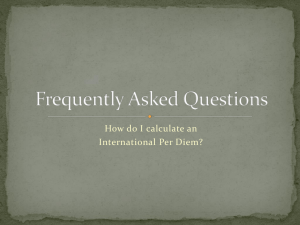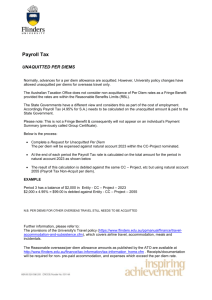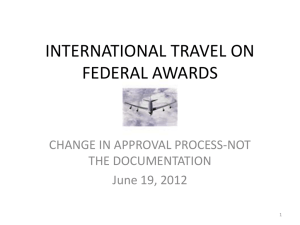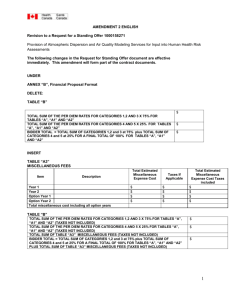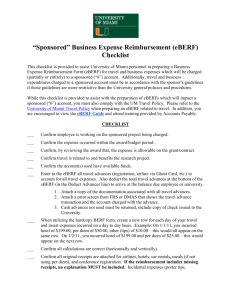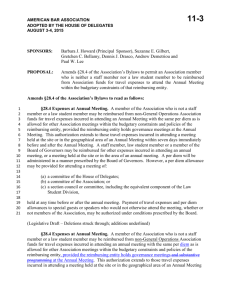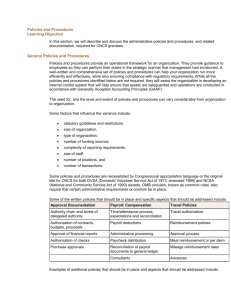Payment of Mileage and Per Diem - New Mexico Public Regulation
advertisement
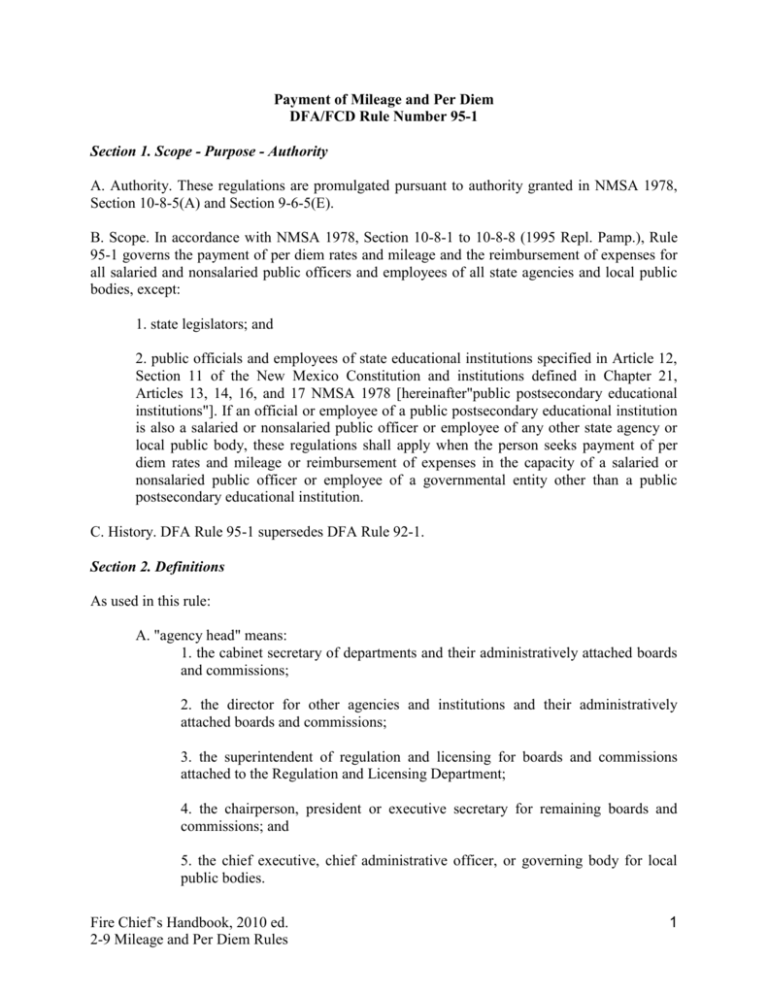
Payment of Mileage and Per Diem DFA/FCD Rule Number 95-1 Section 1. Scope - Purpose - Authority A. Authority. These regulations are promulgated pursuant to authority granted in NMSA 1978, Section 10-8-5(A) and Section 9-6-5(E). B. Scope. In accordance with NMSA 1978, Section 10-8-1 to 10-8-8 (1995 Repl. Pamp.), Rule 95-1 governs the payment of per diem rates and mileage and the reimbursement of expenses for all salaried and nonsalaried public officers and employees of all state agencies and local public bodies, except: 1. state legislators; and 2. public officials and employees of state educational institutions specified in Article 12, Section 11 of the New Mexico Constitution and institutions defined in Chapter 21, Articles 13, 14, 16, and 17 NMSA 1978 [hereinafter"public postsecondary educational institutions"]. If an official or employee of a public postsecondary educational institution is also a salaried or nonsalaried public officer or employee of any other state agency or local public body, these regulations shall apply when the person seeks payment of per diem rates and mileage or reimbursement of expenses in the capacity of a salaried or nonsalaried public officer or employee of a governmental entity other than a public postsecondary educational institution. C. History. DFA Rule 95-1 supersedes DFA Rule 92-1. Section 2. Definitions As used in this rule: A. "agency head" means: 1. the cabinet secretary of departments and their administratively attached boards and commissions; 2. the director for other agencies and institutions and their administratively attached boards and commissions; 3. the superintendent of regulation and licensing for boards and commissions attached to the Regulation and Licensing Department; 4. the chairperson, president or executive secretary for remaining boards and commissions; and 5. the chief executive, chief administrative officer, or governing body for local public bodies. Fire Chief’s Handbook, 2010 ed. 2-9 Mileage and Per Diem Rules 1 B. "board or committee meeting" means the formal convening of public officers who comprise a board, advisory board, commission or committee even if no further business can take place because of the lack of a quorum. C. "designated post of duty" means the address of a public officer's or employee's assignment as determined by the agency. D. "employee" means any person who is in the employ of any New Mexico state agency or local public body within New Mexico whose salary is paid either completely or partially from public money but does not include jurors or jury commissioners. E. "governmental entity" means a New Mexico state agency or local public body within New Mexico. F. "home" means 1) for per diem purposes, the area within a 35-mile radius of the place of legal residence as defined in NMSA 1978, Section 1-1-7 (1995 Repl. Pamp.); 2) for mileage purposes, the place of legal residence as defined in NMSA 1978, Section 1-1-7 (1995 Repl. Pamp.). G. "local public body" means every political subdivision of the state, whether created under general or special act including, but not limited, to counties, municipalities, drainage, conservancy, irrigation, school or other districts, that receives or expends public money from whatever source derived. H. "nonsalaried public officer" means a public officer serving as a member of a board, advisory board, committee or commission who is not entitled to compensation, but is entitled to payment of per diem rates and mileage. I. "out of state" means beyond the exterior boundaries of the State of New Mexico. J. "public officer" means every elected or appointed officer of a governmental entity,including but not limited to: 1. officers of the judicial branch of state government, including judges; 2. officers of the legislative branch of state government, except legislators; and, 3. all board, advisory board, committee and commission members elected or appointed to a board, advisory board, committee or commission specifically authorized by law or validly existing as an advisory committee pursuant to NMSA 1978, Section 9-1-9. K. "secretary" means the secretary of finance and administration. Fire Chief’s Handbook, 2010 ed. 2-9 Mileage and Per Diem Rules 2 L. "travel" means: for per diem purposes, being on official business away from homeas defined in Paragraph F above and at least 35 miles from the designated post of duty of the public officer or employee. However, non-salaried public officers are eligible for per diem for attending meetings in accordance with Section 3(C); and M. "travel voucher" means a payment voucher submitted for the purpose of claiming reimbursement for travel expenditures. Section 3. Per Diem Rates-Proration A. Applicability. Per diem rates shall be paid to public officers and employees only in accordance with the provisions of this section. Per diem rates shall be paid without regard to whether expenses are actually incurred. Where lodging and/or meals are provided or paid for by the agency, the governing body, or another entity, the public officer or employee is entitled to reimbursement only for actual expenses under Section 4. B. Per Diem Rate Computation. Except as provided in Subsections C through I of this section, per diem rates for travel by public officers and employees shall be computed as follows: 1. Partial Day Per Diem Rate. Public officers or employees who occasionally and irregularly travel shall be reimbursed for travel which does not require overnight lodging, but extends beyond a normal work day as follows:. a. for less than 2 hours of travel beyond normal work day, none; b. for 2 hours, but less than 6 hours beyond the normal work day, $8.00; c. for 6 six hours, but less than 12 hours beyond the normal work day, $16.00; d. for 12 hours or more beyond the normal work day, $22.50; "Occasionally and irregularly" means not on a regular basis and infrequently as determined by the agency. For example, an employee is not entitled to per diem rates under this subparagraph if the employee either travels once a week or travels every fourth Thursday of the month. However, the employee is entitled to per diem rates under this subparagraph if the employee either travels once a month with irregular destinations and at irregular times or travels four times in one month and then does not travel again in the next two months, so long as this is not a regular pattern. "Normal work day" means 8 hours within a nine-hour period for all public officers and employees both salaried and nonsalaried, regardless of the officers’ or employees’ regular work schedule. Fire Chief’s Handbook, 2010 ed. 2-9 Mileage and Per Diem Rules 3 2. Overnight Travel. Regardless of the number of hours traveled, travel for public officers and employees where overnight lodging is required shall be reimbursed as follows: a. in state areas $65.00 b. in state special areas $75.00 c. out of state areas $75.00 d. out of state special areas $95.00 or actual lodging and meal expenses under Section 4.. 3. Return from Overnight Travel. On the last day of travel when overnight lodging is no longer required, partial day reimbursement shall be made. To calculate the number of hours in the partial day, begin with the time the traveler initially departed. Divide the number of hours traveled by 24. The hours remaining constitute the partial day which shall be reimbursed as follows: a. for less than 2 hours, none. b. for 2 hours, but less than 6 hours, $8.00. c. for 6 hours or more, but less than 12 hours, $16.00. d. for 12 hours or more, $22.50. 4. Special Area Designations. For all officers and employees, the in state special area shall be Santa Fe. The out of state special areas shall be the areas of New York City, Washington, D.C., Chicago, Los Angeles, San Francisco, Palm Springs, San Diego, Atlanta, Boston, Las Vegas, Atlantic City, Philadelphia and Dallas/Fort Worth designated as metropolitan by the most recent edition of the Rand-McNally road atlas, and areas outside of the continental United States including Alaska and Hawaii. C. Board, Commission and Committee Members. Nonsalaried public officers may receive per diem as follows: 1. Official Board, Commission and Committee Meetings. a. State Nonsalaried Public Officers. Nonsalaried public officers of the state may elect to receive either: (1) $75.00 per meeting day for attending each board or committee meeting; or (2) per diem rates in accordance with Subsection B of this section. b. Local Nonsalaried Public Officers. Nonsalaried public officers of local public bodies may elect to receive either:. (1) $75.00 per meeting day for attending each board or committee meeting day; or (2) per diem rates in accordance with Subsection B of this section, provided that the local governing body has not established a lesser rate. c. Municipal Nonsalaried Public Officers. Nonsalaried public officers of municipalities may elect to receive either: Fire Chief’s Handbook, 2010 ed. 2-9 Mileage and Per Diem Rules 4 (1) $75.00 per meeting day for attending each board or committee meeting; or (2) per diem rates in accordance with Subsection B of this section, provided that the board or commission meeting is held outside of the municipal boundaries. 2. Other Official Meetings. Nonsalaried public officers may receive per diem rates for travel on official business that does not constitute a board, advisory board, committee or commission meeting only in accordance with Subsection B of this section. 3. Members Serving in Dual Capacities. Nonsalaried public officers who also serve as public officers or employees of state agencies or local public bodies may receive mileage or per diem rates from only one public entity for any travel or meeting attended. Furthermore, nonsalaried public officers who are also public officers or employees may not receive per diem rates for attending meetings held in the place of their home or at their designated posts of duty unless they are on leave from their positions as public officers or employees. Local public bodies may adopt regulations with respect to the receipt of per diem rates by employees or officers of local public bodies who also serve on boards or commissions subject to this rule. D. Temporary Assignment. Public officers and employees may be reassigned temporarily to another duty station.. 1. Routine Reassignment. Public officers and employees subject to periodic reassignment of duty stations or districts as a normal requirement of their employment will not be eligible for per diem rates after the time of arrival at the new duty station or district. 2. Nonroutine Reassignment. Public officers or employees not normally subject to periodic reassignments who are temporarily assigned to another office of a state agency away from home will receive per diem for the first 30 calendar days of their assignment only, unless approval of the secretary is given to extend per diem payments upon showing that the assignment is necessary and temporary. Except in such extraordinary circumstances,after 30 calendar days, the place where the employee or officer is assigned will be regarded as the designated post of duty. E. State Highway and Transportation Department. The State Highway and Transportation Department may adopt special policies pertaining to payment of per diem rates for temporary assignments. Such policies shall be subject to the annual approval of the secretary. F. Department of Public Safety. The Department of Public Safety may adopt special policies pertaining to payment of per diem rates, mileage and subsistence allowances authorized by law for commissioned officers. Such policies shall be subject to the annual approval of the secretary. G. Travel for Educational Purposes. A public officer or employee shall not be reimbursed for more than 30 calendar days of per diem in any fiscal year for attending educational or training programs unless approval has been obtained from the secretary. Fire Chief’s Handbook, 2010 ed. 2-9 Mileage and Per Diem Rules 5 H. Per Diem in Conjunction with Other Leave. While traveling, if a public officer or employee takes sick, annual or authorized leave without pay for more than four hours of the normal work day, per diem shall not be allowed for that day unless authorized in writing by the agency head. I. Illness or Emergency. Agency heads may grant permission, in writing, to pay per diem rates and travel reimbursement to an employee or public officer who becomes ill or is notified of a family emergency while traveling on official business and must either remain away from home or discontinue the official business to return home. Section 4. Reimbursement of Actual Expenses in Lieu of Per Diem Rates. A. Applicability. Upon written request of a public officer or an employee, agency heads may grant written approval for a public officer or employee of that agency or local public body to be reimbursed actual expenses in lieu of the per diem rate where overnight travel is required. B. Overnight Travel. For overnight travel for state officers and employees where overnight lodging is required, the public officer or employee will be reimbursed as follows: 1. Actual Reimbursement for Lodging. A public officer or an employee may elect to be reimbursed actual expenses for lodging not exceeding the single occupancy room charge (including tax) in lieu of the per diem rate set forth in this section. Whenever possible, public officers and employees should stay in hotels which offer government rates. Agencies, public officers or employees who incur lodging expenses in excess of $200 per night must obtain the signature of the agency head or chairperson of the governing board on the travel voucher prior to requesting reimbursement and on the encumbering document at the time of encumbering the expenditure. 2. Actual Reimbursement for Meals. Actual expenses for meals are limited by NMSA 1978, Section 10-8-4(K)(2) (1995 Repl. Pamp.) to a maximum of $22.50 for a 24-hour period. 3. Receipts Required. The public officer or employee must submit receipts for the actual meal and lodging expenses incurred. Under circumstances where the loss of receipts would create a hardship, an affidavit from the officer or employee attesting to the expenses may be substituted for actual receipts. The affidavit must accompany the travel voucher and include the signature of the agency head or governing board. C. Return from Overnight Travel. On the last day of travel when overnight lodging is no longer required, partial day reimbursement shall be made. To calculate the number of hours in the partial day, begin with the time the traveler initially departed on the travel. Divide the total number of hours traveled by 24. The hours remaining constitute the partial day which shall be reimbursed as follows: 1. for less than 2 hours, none. 2. for 2 hours, but less than 6 hours, $8.00. 3. for 6 hours or more, but less than 12 hours, $16.00. 4 for 12 hours or more, $22.50. Fire Chief’s Handbook, 2010 ed. 2-9 Mileage and Per Diem Rules 6 5. No reimbursement for actual expenses will be granted in lieu of partial day per diem rates. Section 5. Travel Advances A. Authorizations. Upon written request accompanied by a travel voucher, agency heads and governing boards of local public bodies or their authorized designees may approve a public officer's or employee's request to be advanced up to 80 percent of per diem rates and mileage cost or for the actual cost of lodging and meals pursuant to Sections 3 and 4 and for other travel expenses that may be reimbursed under Section 7. Requests for travel advances shall not be submitted to the Financial Control Division of the Department of Finance and Administration more than two weeks prior to travel unless, by processing the request earlier, significant savings can be realized for travel by common carrier or for registration fees for seminars and conferences. B. Travel Period. A travel advance may be authorized either for a single trip or on a monthly basis for public officers and employees who travel continually throughout the month. Payment shall be made only upon vouchers submitted with attached authorization for each travel period. 1. Single Trip Advances. Where a travel advance is made for a single trip, the officer or employee shall remit, within 5 working days of the return from the trip, a refund of any excess advance payment to the agency. The agency or local public body shall deposit the refund and reduce the disbursement recorded when the money was advanced. 2. Monthly Advances. Where monthly advances are made, employees shall remit to the agency, at the end of each month, any excess advance payments together with a thorough accounting of all travel advances and expenditures as required by the secretary. Where a travel advance is approved for the next month, the agency head may authorize the use of excess advance payments from the previous month as part of the advance for the next month in lieu of having the employee remit the excess funds. C. Agency Records. Each agency is responsible for maintaining records of travel advances authorized by the agency head or the agency head's authorized designee. 1. Employee Ledgers. Each state agency shall keep individual employee ledgers for travel advances. The ledger shall include the following information to provide an adequate audit trail: Fire Chief’s Handbook, 2010 ed. 2-9 Mileage and Per Diem Rules 7 Employee ____________________________________ No.________________________ Division_____________________________________ Fiscal Year__________________ Date of Travel Advance Date of Destination Per Diem Advance Earned Additional Per Diem or Refund Due 2. Year-end Closing. Each state agency shall review all travel advances prior to the end of the fiscal year and collect or pay all outstanding amounts if possible. Any receivables or payables outstanding at year-end must be recorded on the books and records of the agency. D. Local Public Bodies. Local public bodies may grant prior written approval for travel advances as authorized by regulation of the governing body of the local public body. Section 6. Mileage - Private Conveyance A. Applicability. Mileage accrued in the use of a private conveyance shall be paid only in accordance with the provisions of this section. B. Rate. Public officers and employees of state agencies shall be reimbursed for mileage accrued in the use of a private automobile or aircraft in the discharge of official duties as follows: 1. privately owned automobile, 25 cents per mile. 2. privately owned airplane, 40 cents per nautical mile. C. Local Public Bodies. Public officers and employees of local public bodies may be reimbursed for mileage accrued in the use of a private conveyance in the discharge of official duties at the statutory rates unless such rates have been reduced by the governing bodies of the local public body pursuant to NMSA 1978, Section 10-8- 5(D). D. Privately Owned Automobile. For conveyance in the discharge of official duties by privately owned automobile, mileage accrued shall be reimbursed at the rate set forth in this section as follows: 1. pursuant to the mileage chart of the official state map published by the State Highway and Transportation Department for distances in New Mexico and the most recent edition of the Rand-McNally road atlas for distances outside of New Mexico; or 2. pursuant to actual mileage if the beginning and ending odometer reading is certified as true and correct by the traveler; and Fire Chief’s Handbook, 2010 ed. 2-9 Mileage and Per Diem Rules 8 a. the destination is not included on the official state map or on the Rand McNally road atlas, or, b. at the destination(s) of the public officer or employee, the public officer or employee was required to use the private conveyance in performance of official duties. E. Privately Owned Airplane. Mileage accrued in the use of a privately owned airplane shall be reimbursed at the rate set forth in this section as follows: 1. pursuant to the New Mexico Aeronautical Chart published by the State Highway and Transportation Department, Aviation Division, for distances in New Mexico and other states' air maps for distances outside of New Mexico; or 2. pursuant to actual air mileage if certification is provided by the pilot, or a beginning and ending reading of actual mileage if the reading is certified as true and correct by the traveler, and the destination is not included on an air map. F. Reimbursement Limit for Out of State Travel. Total mileage reimbursement for out of state travel by privately owned automobile or privately owned airplane shall not exceed the total coach class commercial airfare that would have been reimbursed those traveling had they traveled by common carrier. This subsection shall not apply to a public school when transporting students. G. Additional Mileage Provision. Mileage accrued while on official business shall be reimbursed for travel on official business. An agency head or designee may authorize by memorandum reimbursement for mileage from a point of origin farther from the destination than the designated post of duty in appropriate circumstances. The memorandum must accompany the payment voucher. If official business is transacted while commuting from home to post of duty or from post of duty to home, mileage shall not be paid for the number of miles between post of duty and home. Odometer readings showing additional miles accrued for official business must be provided to the agency for payment. Section 7. Reimbursement for Other Expenses Public officers and employees may be reimbursed for certain actual expenses in addition to per diem rates. 1. Receipts Not Required. Public officers and employees may be reimbursed without receipts for the following expenses: a. taxi or other transportation fares at the destination of the traveler; b. gratuities as allowed by the agency head or designee; and c. parking fees Fire Chief’s Handbook, 2010 ed. 2-9 Mileage and Per Diem Rules 9 In an amount of $6.00 per day not to exceed a total of $30.00 per trip. If more than $6.00 per day or $30.00 per trip is claimed, the entire amount of the reimbursement claim must be accompanied by receipts. 2. Receipts Required. Public officers and employees may be reimbursed for the following expenses provided that receipts for all such expenses are attached to the reimbursement voucher: a. actual costs for travel by common carrier, provided such travel is accomplished in the most economical manner practical; b. rental cars or charter aircraft, provided less expensive public transportation is not available or appropriate; c. registration fees for educational programs or conferences,provided, if the fee includes lodging or meals, then no per diem. rates shall be paid and only actual expenses paid by the officer or employee and not included in the fee shall be reimbursed within the limits of Section 4; and d. professional fees or dues that are beneficial to the agency's operations or mission. Under circumstances where the loss of receipts would deny reimbursement and create a hardship, an affidavit from the officer or employee attesting to the expenses may be substituted for actual receipts. The affidavit must accompany the travel voucher and include the signature of the agency head or governing board. 3. Local Public Bodies. Local public bodies may adopt regulations governing the reimbursement of actual expenses incurred in addition to per diem rates and mileage. Section 8. Travel Vouchers Travel vouchers and supporting schedules and documents shall conform to the policies and procedures manuals issued by the Financial Control Division of the Department of Finance and Administration. Section 9. Effective Dates All sections shall be effective upon publication in the New Mexico Register. Fire Chief’s Handbook, 2010 ed. 2-9 Mileage and Per Diem Rules 10
